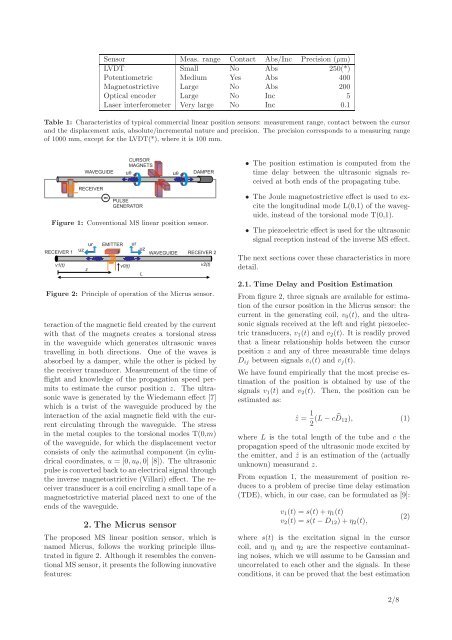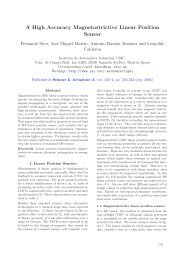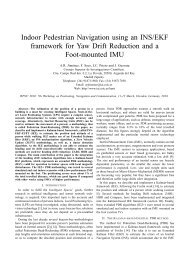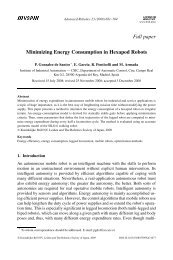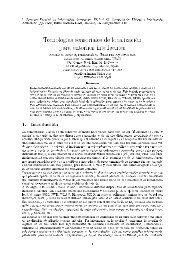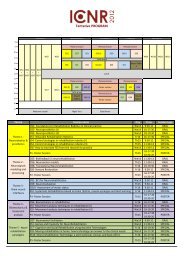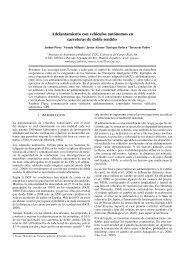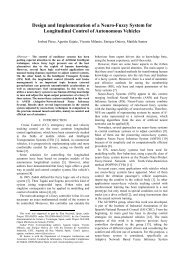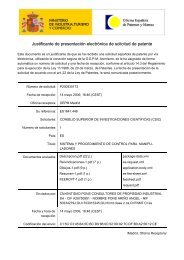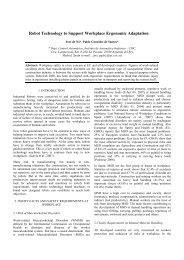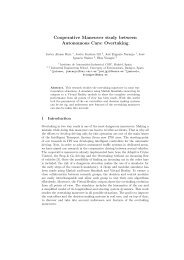Download PDF - Centro de Automática y Robótica
Download PDF - Centro de Automática y Robótica
Download PDF - Centro de Automática y Robótica
You also want an ePaper? Increase the reach of your titles
YUMPU automatically turns print PDFs into web optimized ePapers that Google loves.
Sensor Meas. range Contact Abs/Inc Precision (µm)<br />
LVDT Small No Abs 250(*)<br />
Potentiometric Medium Yes Abs 400<br />
Magnetostrictive Large No Abs 200<br />
Optical enco<strong>de</strong>r Large No Inc 5<br />
Laser interferometer Very large No Inc 0.1<br />
Table 1: Characteristics of typical commercial linear position sensors: measurement range, contact between the cursor<br />
and the displacement axis, absolute/incremental nature and precision. The precision corresponds to a measuring range<br />
of 1000 mm, except for the LVDT(*), where it is 100 mm.<br />
WAVEGUIDE<br />
RECEIVER<br />
CURSOR<br />
MAGNETS<br />
u<br />
PULSE<br />
GENERATOR<br />
u<br />
DAMPER<br />
Figure 1: Conventional MS linear position sensor.<br />
ur EMITTER ur<br />
RECEIVER 1<br />
uz<br />
uz<br />
WAVEGUIDE RECEIVER 2<br />
v1(t)<br />
z<br />
v0(t)<br />
L<br />
v2(t)<br />
Figure 2: Principle of operation of the Micrus sensor.<br />
teraction of the magnetic field created by the current<br />
with that of the magnets creates a torsional stress<br />
in the wavegui<strong>de</strong> which generates ultrasonic waves<br />
travelling in both directions. One of the waves is<br />
absorbed by a damper, while the other is picked by<br />
the receiver transducer. Measurement of the time of<br />
flight and knowledge of the propagation speed permits<br />
to estimate the cursor position z. The ultrasonic<br />
wave is generated by the Wie<strong>de</strong>mann effect [7]<br />
which is a twist of the wavegui<strong>de</strong> produced by the<br />
interaction of the axial magnetic field with the current<br />
circulating through the wavegui<strong>de</strong>. The stress<br />
in the metal couples to the torsional mo<strong>de</strong>s T(0,m)<br />
of the wavegui<strong>de</strong>, for which the displacement vector<br />
consists of only the azimuthal component (in cylindrical<br />
coordinates, u = [0,u θ ,0] [8]). The ultrasonic<br />
pulse is converted back to an electrical signal through<br />
the inverse magnetostrictive (Villari) effect. The receiver<br />
transducer is a coil encircling a small tape of a<br />
magnetostrictive material placed next to one of the<br />
ends of the wavegui<strong>de</strong>.<br />
2. The Micrus sensor<br />
The proposed MS linear position sensor, which is<br />
named Micrus, follows the working principle illustrated<br />
in figure 2. Although it resembles the conventional<br />
MS sensor, it presents the following innovative<br />
features:<br />
• The position estimation is computed from the<br />
time <strong>de</strong>lay between the ultrasonic signals received<br />
at both ends of the propagating tube.<br />
• The Joule magnetostrictive effect is used to excite<br />
the longitudinal mo<strong>de</strong> L(0,1) of the wavegui<strong>de</strong>,<br />
instead of the torsional mo<strong>de</strong> T(0,1).<br />
• The piezoelectric effect is used for the ultrasonic<br />
signal reception instead of the inverse MS effect.<br />
The next sections cover these characteristics in more<br />
<strong>de</strong>tail.<br />
2.1. Time Delay and Position Estimation<br />
From figure 2, three signals are available for estimation<br />
of the cursor position in the Micrus sensor: the<br />
current in the generating coil, v 0 (t), and the ultrasonic<br />
signals received at the left and right piezoelectric<br />
transducers, v 1 (t) and v 2 (t). It is readily proved<br />
that a linear relationship holds between the cursor<br />
position z and any of three measurable time <strong>de</strong>lays<br />
D ij between signals v i (t) and v j (t).<br />
We have found empirically that the most precise estimation<br />
of the position is obtained by use of the<br />
signals v 1 (t) and v 2 (t). Then, the position can be<br />
estimated as:<br />
ẑ = 1 2 (L − c ̂D 12 ), (1)<br />
where L is the total length of the tube and c the<br />
propagation speed of the ultrasonic mo<strong>de</strong> excited by<br />
the emitter, and ẑ is an estimation of the (actually<br />
unknown) measurand z.<br />
From equation 1, the measurement of position reduces<br />
to a problem of precise time <strong>de</strong>lay estimation<br />
(TDE), which, in our case, can be formulated as [9]:<br />
v 1 (t) = s(t) + η 1 (t)<br />
v 2 (t) = s(t − D 12 ) + η 2 (t),<br />
(2)<br />
where s(t) is the excitation signal in the cursor<br />
coil, and η 1 and η 2 are the respective contaminating<br />
noises, which we will assume to be Gaussian and<br />
uncorrelated to each other and the signals. In these<br />
conditions, it can be proved that the best estimation<br />
2/8


